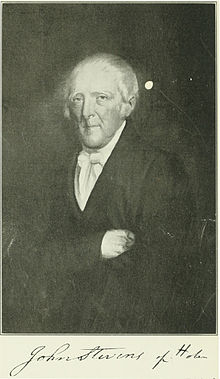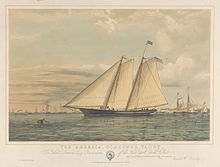Edwin Augustus Stevens
Edwin Augustus Stevens (born July 28, 1795 in New Castle Point, Hoboken , New Jersey , † August 8, 1868 in Paris ) was an American engineer, inventor and entrepreneur. Together with his brother Robert Livingston Stevens , he designed the first ironclad for the United States Navy in 1844 . In his will, Stevens decreed that the Stevens Institute of Technology , now the fourth oldest technical university in America , will be founded from his estate . Stevens was also the Commodore of the New York Yacht Club (NYYC).
family
Edwin Augustus Stevens came from the influential Stevens family and was born in Castle Point, Hoboken in 1795. He was one of the most important inventors of the family, which the non-fiction author Oliver E. Allen characterized in 1987 as "The First Family Of Inventors" . Over several generations, the Stevens in New Jersey developed steamships , railroads , warships and a variety of other technologies.
ancestors

His great-grandfather John Stevens (1682-1737) immigrated to the States at the age of 17 and was a port collector in Perth Amboy , New Jersey. He acquired land and was one of thirteen signatories to buy 700,000 acres of land on Lake George in present-day Fulton County from the Mohawk Indians in the so-called Kayaderosseras Tract in 1704 for minimal compensation . The grandfather, also named John Stevens (1715–1792), was a member of the Continental Congress as a delegate for the state of New Jersey . His father, the third John Stevens (1749-1838), was veteran in the Revolutionary War , engineer and pioneer of steam navigation . His mother Rachel Cox (1761-1839) came from New Brunswick and was a descendant of the Langeveldts (Longfields) who had settled in New Brunswick, originally the area of the Lenni Lenape , in the 17th century .
Edwin Augustus' parents bought the land that gave birth to what is now Hoboken , New Jersey . In Castle Point on the Hudson River in 1808 they built the castle-like house from which the Stevens Institute of Technology named after Edwin Augustus was to emerge and in which Edwin Augustus Stevens grew up.
Siblings, wives and children

Edwin Augustus Stevens was the sixth child. Among his ten siblings were businessman John Cox Stevens , eldest brother and co-founder of the New York Yacht Club. His brother Robert Livington Stevens worked as a businessman, was president of the United New Jersey Railroad and Canal Company and, like his father, an engineer and designer.
Edwin Augustus Stevens married Mary Barton Picton in 1836, daughter of Reverend Thomas Picton of Princeton, New Jersey . The marriage resulted in a daughter, Mary Picton Stevens (born May 19, 1840 - September 21, 1903), who married the politician Muscoe Russell Hunter Garnett from Virginia and later Edward Parke Custis Lewis, ambassador to Portugal .
After the death of his wife Mary in 1854, Edwin Augustus Stevens entered into a new marriage with Martha Bayard Dod (* May 15, 1831, † April 1, 1899). Martha was the daughter of Albert Baldwin Dod (1805-1845), a mathematics professor at Princeton University , and Caroline Smith Bayard, daughter of Samuel Bayard (1766-1840) and granddaughter of the Continental Congressman John Bubenheim Bayard (1738-1808).
This marriage had six children: John Stevens (* July 1856), grandfather of Millicent Fenwick , Republican politician , civil rights activist and publicist ; Edwin Augustus Stevens Jr. (born March 14, 1858), marine engineer and co-founder of Cox & Stevens; Caroline Bayard Stevens (born November 21, 1859), who married Archibald Alexander and then H. Otto Wittpenn , Mayor of Jersey City ; Robert Livingston Stevens (born August 26, 1864); Charles Albert Stevens (born December 14, 1865); and Richard Stevens (* May 1868).
Career and inventions
The father introduced Edwin Augustus Stevens to the family business at an early age. As early as 1821, at the age of 26, he took full responsibility for the family estates in Hoboken and other properties.
In 1821 he developed the Stevens plow , a cast iron plow with a curved cover wing. The plow was widely used on New Jersey farms. His numerous technical inventions also included a two-horse dump wagon for New York City; a closed fireroom system for the boiler fan of the family steamship fleet ; and the vestibule car for the United New Jersey Railroad and Canal Company ( Camden and Amboy Railroad ) which his brother Robert Livington presided over. With the founding of the railway line, the two brothers realized the plans their father had begun in 1810 to connect the family ferry station in Trenton with Philadelphia with a private, commercially successful railway line .
After their father's death in 1838, Edwin Augustus and his brother Robert worked for a US government commission to design the first armored ship for the United States Navy . They had a large dry dock excavated on the family property in Hoboken for the construction . After conducting various tests to determine the amount of armor needed for self-defense, the two brothers built a massive ship that went down in history as the Stevens Battery . Even if the ship was not fully completed due to a lack of funding, it formed the basis for the development of modern armored warships. A smaller version, the 1844 USS Naugatuck , had smaller deployments in the Civil War . After the American Civil War, both ships were scrapped; Negotiations to sell the Stevens Battery to Prussia had previously failed.
Commodore of the New York Yacht Club

Edwin Augustus Stevens was a member of the New York Yacht Club (NYYC) finance consortium that built Yacht America . The sole purpose was to participate in the race to the One Hundred Sovereigns Cup around the Isle of Wight . The race was carried out by the Royal Yacht Squadron (RYS) as a fleet race and 15 out of 18 registered British yachts started. The traditional course set out in the sailing instruction was called The Queen's Course , in honor of Queen Victoria . The One Hundred Sovereigns Cup won the America - with Edwin Augustus Stevens and his brother John Cox on board - August 22, 1851 53 miles at 20:37 local time 20 minutes ahead of the 14 British participants ( Aurora , Arrow , Alarm and other). On his return to New York, John Cox Stevens donated the One Hundred Sovereigns Cup to the New York Yacht Club and with this award founded the America's Cup , the oldest sailing regatta still held today . The first regatta took place off New York in 1870 between the yachts Magic (USA) and Gambria (Great Britain) (winner: Magic ).
His older brother John Cox Stevens was in charge of founding the NYYC on July 30, 1844 and was the first Commodore of the club, one of the world's most important and influential sailing clubs and which held the America's Cup for 132 years until 1983 - the longest winning streak in sports history.
In the 1860s, Edwin Augustus Stevens became a Commodore of NYYC. He was the last representative of the "old guard" in this function. When a new generation gained influence and had large schooners built and steered by professionals, he did not want to go along this path and resigned as Commodore in 1866.
Edwin Augustus Stevens died in Paris in August 1868.
Discount for the technical university
In his last will Edwin Augustus Stevens decreed that from his estate his lands in New Castle Point and $ 150,000 for equipment of an institute of learning to build and $ 500,000 (institution of learning) to be used. Due to the close ties of the Stevens family to engineering , the estate administrators decided to use the funds for a technical institute, today's Stevens Institute of Technology , which is named after him . The private Stevens Institute of Technology, founded in 1870, is the fourth oldest technical university in America.
The building of the School of Engineering and Science , one of the four faculties on campus , also bears the name The Edwin A. Stevens Hall . The building is home to the renowned Debaun Auditorium , which is over 100 years old and has been restored to its original state.
literature
- Small, Stephen C .: The Ship That Couldn't Be Built. Naval History, Vol. 22, No. October 5, 2008.
Web links
- Stevens Institute of Technology , Edwin Augustus Stevens, biography
- New York Yacht Club (NYYC) , Official Website
- Department Of The Navy - Naval Historical Center , USS Naugatuck
Individual evidence
- ↑ a b c Allen, Oliver E .: "The First Family of Inventors" ( Memento from January 13, 2010 in the Internet Archive ), Invention & Technology Magazine , Fall 1987, Volume 3, Issue 2.
- ↑ Fulton nygenweb , William Loveday Jr .: Birth of a County. Fulton County created from dispute among neighbors.
- ↑ The Cox Family in America (1912), pp. 223-7.
- ↑ "Mrs. Martha B. Stevens Dead " . The New York Times , April 2, 1899
- ↑ Stevens Institute of Technology: About Stevens: The Stevens Brothers' Railroad ( Memento of the original from May 7, 2008 in the Internet Archive ) Info: The archive link was inserted automatically and has not yet been checked. Please check the original and archive link according to the instructions and then remove this notice.
- ↑ Royal Yacht Squadron: The Yacht America ( Memento of the original from October 16, 2008 in the Internet Archive ) Info: The archive link was inserted automatically and has not yet been checked. Please check the original and archive link according to the instructions and then remove this notice. Retrieved January 27, 2009
- ↑ America's Cup: AC-CLOPAEDIA - TIMELINE ( January 14, 2009 memento in the Internet Archive ). Retrieved January 24, 2009
- ↑ Stevens Institute of Technology ( Memento of the original from October 12, 2013 in the Internet Archive ) Info: The archive link was inserted automatically and has not yet been checked. Please check the original and archive link according to the instructions and then remove this notice. , History, Campus History
| personal data | |
|---|---|
| SURNAME | Stevens, Edwin Augustus |
| BRIEF DESCRIPTION | American engineer, entrepreneur, and sailor |
| DATE OF BIRTH | July 28, 1795 |
| PLACE OF BIRTH | New Castle Point, Hoboken , New Jersey |
| DATE OF DEATH | August 8, 1868 |
| Place of death | Paris |


